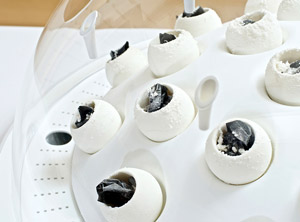
Grandma’s favourite magic mushroom recipe

Once you have hand-picked your waste and it has been covered by the fungi, you can pick your own mushroom, too (Photo: Livin Studio)
|
Just a few years ago, molecular gastronomy gripped the attention of gourmet taste buds worldwide. An egg that tastes like watermelon? Transparent ravioli? Vapour with a flavour? There appear to be no boundaries when hunger and creativity meet. It turns out that human appetite could also help solve the growing plastic waste problem. Researchers at Utrecht University and Livin Studio have come up with a new “cooking method. Here is the recipe:
Ingredients: Plastic waste, UV light, gelatin and a fungi.
Preparation: Treat plastic with UV light, then mix in special container with gelatin and fungi. Wait a few weeks. Extract your fungi-covered plastic waste snack and eat.
Bon appetit!
Researchers have long been on the hunt for ways to break down non-biodegradable plastic—and they’ve come up with some pretty creative concepts, like letting hordes of mealworms chow down on it. But what if you could take broken-down plastic and turn it into food? Modern Farmer’s Anna Roth reports on an Austrian designer who is doing just that with the help of a plastic-eating mushroom.
The secret is in a rare fungus called Pestalotiopsis microspora. A few years ago, researchers discovered the fungus—which can consume a type of plastic called polyurethane—in the Amazonian rainforests of Ecuador. Designer Katharina Unger, who has previously done things like turn fly eggs into human-friendly food, harnessed the power of plastic-eating fungus in collaboration with scientists at Utrecht University and Julia Kaisinger of LIVIN design studio, Roth reports.
The result is called Fungi Mutarium—a striking combination of creativity, science and design. The prototype project uses mushroom-like pods of agar (a seaweed-based gelatin) as a nutrient-packed base for the fungus. The pods are filled with plastic and fungi and covered with a “growth sphere.” Over time, the fungus gobbles up the plastic along with the sugar and starches contained in the agar holder. The puffy, mushroom-like cup that results can be filled with other food or eaten whole.
Unger tells Dezeen that the end result can vary in flavor depending on the strain of fungus, but that it’s been described as sweet or licorice-like. From start to finish, the entire process takes several months.













